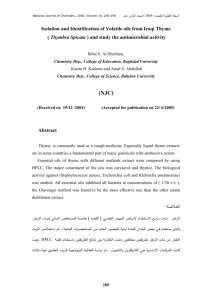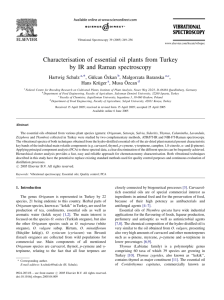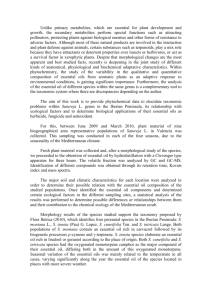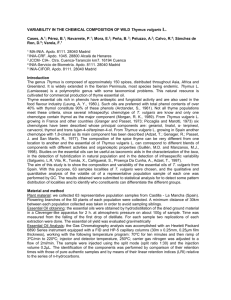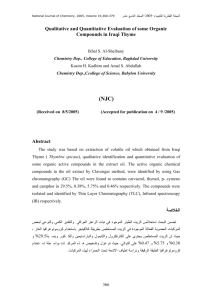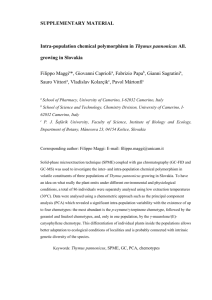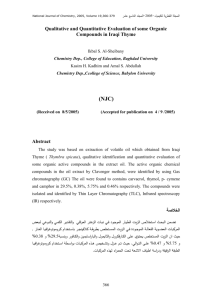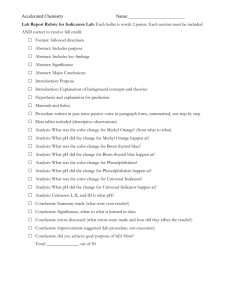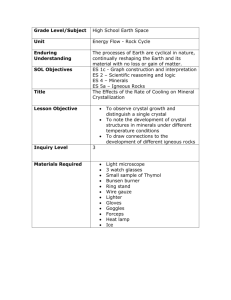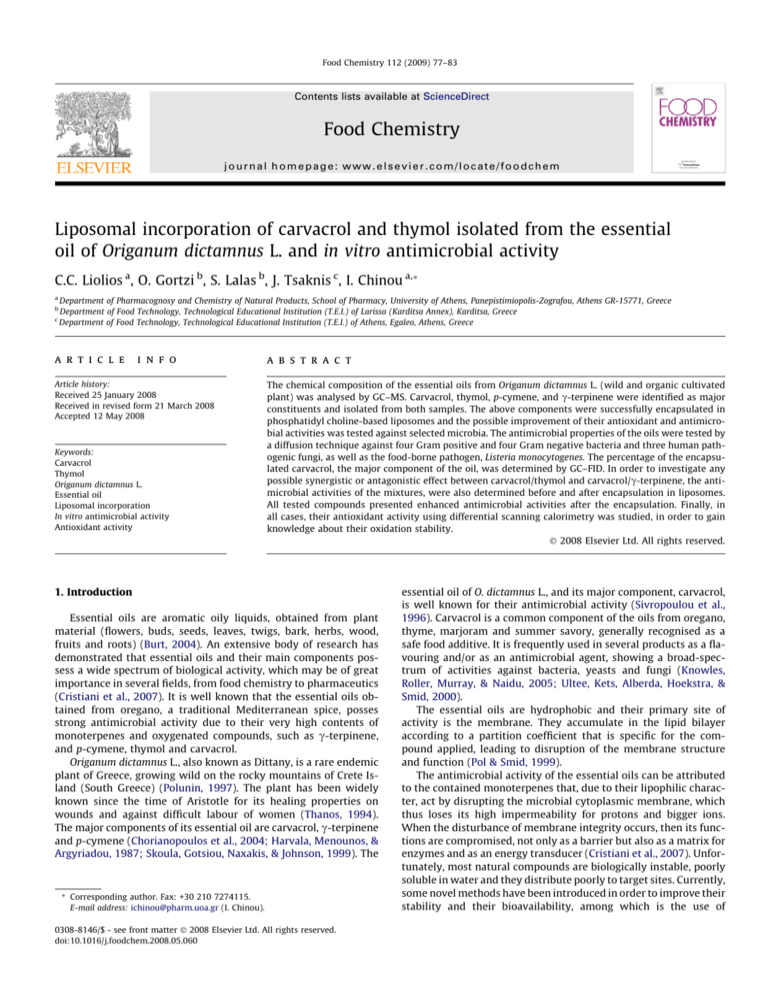
Food Chemistry 112 (2009) 77–83
Contents lists available at ScienceDirect
Food Chemistry
journal homepage: www.elsevier.com/locate/foodchem
Liposomal incorporation of carvacrol and thymol isolated from the essential
oil of Origanum dictamnus L. and in vitro antimicrobial activity
C.C. Liolios a, O. Gortzi b, S. Lalas b, J. Tsaknis c, I. Chinou a,*
a
Department of Pharmacognosy and Chemistry of Natural Products, School of Pharmacy, University of Athens, Panepistimiopolis-Zografou, Athens GR-15771, Greece
Department of Food Technology, Technological Educational Institution (T.E.I.) of Larissa (Karditsa Annex), Karditsa, Greece
c
Department of Food Technology, Technological Educational Institution (T.E.I.) of Athens, Egaleo, Athens, Greece
b
a r t i c l e
i n f o
Article history:
Received 25 January 2008
Received in revised form 21 March 2008
Accepted 12 May 2008
Keywords:
Carvacrol
Thymol
Origanum dictamnus L.
Essential oil
Liposomal incorporation
In vitro antimicrobial activity
Antioxidant activity
a b s t r a c t
The chemical composition of the essential oils from Origanum dictamnus L. (wild and organic cultivated
plant) was analysed by GC–MS. Carvacrol, thymol, p-cymene, and c-terpinene were identified as major
constituents and isolated from both samples. The above components were successfully encapsulated in
phosphatidyl choline-based liposomes and the possible improvement of their antioxidant and antimicrobial activities was tested against selected microbia. The antimicrobial properties of the oils were tested by
a diffusion technique against four Gram positive and four Gram negative bacteria and three human pathogenic fungi, as well as the food-borne pathogen, Listeria monocytogenes. The percentage of the encapsulated carvacrol, the major component of the oil, was determined by GC–FID. In order to investigate any
possible synergistic or antagonistic effect between carvacrol/thymol and carvacrol/c-terpinene, the antimicrobial activities of the mixtures, were also determined before and after encapsulation in liposomes.
All tested compounds presented enhanced antimicrobial activities after the encapsulation. Finally, in
all cases, their antioxidant activity using differential scanning calorimetry was studied, in order to gain
knowledge about their oxidation stability.
Ó 2008 Elsevier Ltd. All rights reserved.
1. Introduction
Essential oils are aromatic oily liquids, obtained from plant
material (flowers, buds, seeds, leaves, twigs, bark, herbs, wood,
fruits and roots) (Burt, 2004). An extensive body of research has
demonstrated that essential oils and their main components possess a wide spectrum of biological activity, which may be of great
importance in several fields, from food chemistry to pharmaceutics
(Cristiani et al., 2007). It is well known that the essential oils obtained from oregano, a traditional Mediterranean spice, posses
strong antimicrobial activity due to their very high contents of
monoterpenes and oxygenated compounds, such as c-terpinene,
and p-cymene, thymol and carvacrol.
Origanum dictamnus L., also known as Dittany, is a rare endemic
plant of Greece, growing wild on the rocky mountains of Crete Island (South Greece) (Polunin, 1997). The plant has been widely
known since the time of Aristotle for its healing properties on
wounds and against difficult labour of women (Thanos, 1994).
The major components of its essential oil are carvacrol, c-terpinene
and p-cymene (Chorianopoulos et al., 2004; Harvala, Menounos, &
Argyriadou, 1987; Skoula, Gotsiou, Naxakis, & Johnson, 1999). The
* Corresponding author. Fax: +30 210 7274115.
E-mail address: ichinou@pharm.uoa.gr (I. Chinou).
0308-8146/$ - see front matter Ó 2008 Elsevier Ltd. All rights reserved.
doi:10.1016/j.foodchem.2008.05.060
essential oil of O. dictamnus L., and its major component, carvacrol,
is well known for their antimicrobial activity (Sivropoulou et al.,
1996). Carvacrol is a common component of the oils from oregano,
thyme, marjoram and summer savory, generally recognised as a
safe food additive. It is frequently used in several products as a flavouring and/or as an antimicrobial agent, showing a broad-spectrum of activities against bacteria, yeasts and fungi (Knowles,
Roller, Murray, & Naidu, 2005; Ultee, Kets, Alberda, Hoekstra, &
Smid, 2000).
The essential oils are hydrophobic and their primary site of
activity is the membrane. They accumulate in the lipid bilayer
according to a partition coefficient that is specific for the compound applied, leading to disruption of the membrane structure
and function (Pol & Smid, 1999).
The antimicrobial activity of the essential oils can be attributed
to the contained monoterpenes that, due to their lipophilic character, act by disrupting the microbial cytoplasmic membrane, which
thus loses its high impermeability for protons and bigger ions.
When the disturbance of membrane integrity occurs, then its functions are compromised, not only as a barrier but also as a matrix for
enzymes and as an energy transducer (Cristiani et al., 2007). Unfortunately, most natural compounds are biologically instable, poorly
soluble in water and they distribute poorly to target sites. Currently,
some novel methods have been introduced in order to improve their
stability and their bioavailability, among which is the use of
78
C.C. Liolios et al. / Food Chemistry 112 (2009) 77–83
liposomal
encapsulation
(Shoji
&
Nakashima,
2004).
Microencapsulation reduces reactivity with the environment
(water, oxygen, light), decreases the evaporation or the transfer rate
to the outside environment, promotes handling ability, masks taste
and enhances dilution to achieve a uniform distribution in the final
product when used in very small amounts (Gibbs, Kermasha, Alli, &
Mulligan, 1999; Versic, 1988). Now, natural compounds are considered as health-promoting ingredients in food industry (Shoji &
Nakashima, 2004). The use of liposomes, in order to deliver food flavours and nutrients, can also provide the necessary protection
against their oxidation, while the incorporation of food antimicrobials could aid in the protection of food products against growth of
spoilage and pathogenic microorganisms (Taylor & Davidson,
2005).
The overall objective of the present research was to use O. dictamnus as a source of carvacrol and thymol, which are its main
compounds, and, furthermore, to check any possible improvement
of their antioxidant and antimicrobial activity, by encapsulating
them in phosphatidyl choline-based liposomes, against selected
human pathogenic bacteria and fungi, as well as against Listeria
monocytogenes, a food-born microbial pathogen.
Thus, the essential oils from wild and organic cultivated O. dictamnus L. both growth in Crete island (Greece), were extracted and
their chemical composition was determined. Organically cultivated
O. dictamnus L., to our knowledge, has never before been studied.
The main constituents of the oils: carvacrol (42.9–51.7%) and its
isomer, thymol were isolated. The antimicrobial activities of (a)
the oils, (b) the pure compounds, (b1) carvacrol, (b2) thymol, (b3)
c-terpinene, and their mixtures, (c1) carvacrol/thymol (6/1), and
(c2) carvacrol/c-terpinene (3/1) were evaluated, before and after
encapsulation in liposomes. The percentage of the encapsulated
carvacrol was also evaluated. The mixtures of carvacrol with thymol and c-terpinene were also studied, since all compounds act
on the cytoplasmic membrane and an additive or synergistic effect
could be expected. Finally, the antioxidant activity of the above
samples was studied using differential scanning calorimetry
(DSC), in order to gain knowledge about their oxidation stability.
The observed changes in the thermodynamic and antimicrobial
properties of liposomes upon entrapment of carvacrol, thymol,
and the mixture, carvacrol/thymol (6/1), were determined.
2. Materials and methods
2.1. Plant material
The aerial parts of the wild O. dictamnus specimen were collected from Heraclion region (Crete island, Greece) and offered
by E. Kastrinakis (summer, 2004), while the sample of organic cultivation, was a kind offer from G.S. Stivaktakis (‘‘Knossos Aromatic
Plants” company) also from Heraclion region in Crete.
2.2. Isolation procedure
The dried aerial parts of O. dictamnus (400 g for each specimen)
were subjected to hydro-distillation for 4 h, in 2 L of water, using a
Clevenger-type apparatus, with a water-cooled oil receiver to reduce formation of artifacts due to overheating during hydro-distillation. The essential oils were collected and dried over anhydrous
sodium sulphate (Panreac Quimica S.A. Barcelona, Spain) and
stored at 4–6 °C.
2.3. Gas chromatography
GC analyses were carried out on a Perkin–Elmer Clarus 500 gas
chromatograph, with a RTX-5 (30 m 0.25 mm 0.25 lm) fused
capillary column and equipped with a flame ionisation detector
(FID). The column temperature was programmed from 60 to
280 °C at a rate of 3 °C/min. The injector and detector temperatures
were programmed at 230 and 300 °C, respectively. Helium was
used as carrier gas, flow rate 1 ml/min.
2.4. Gas chromatography–mass spectrometry
GC–MS of the essential oils and of the isolated fractions was
carried out using a Hewlett Packard 5973–6890 GC–MS operating
in EI mode (equipped with a HP-5 MS 30 m 0.25 mm 0.25 lm
film thickness capillary column). Helium (1 ml/min) was used as
carrier gas in both cases. Injection temperature was set at 290 °C
and detector temperature at 300 °C. The initial temperature of
the column was 60 °C for 5 min; then it was raised to 280 °C at
3 °C/min, and held there for 30 min.
2.5. Identification of components
All components were identified by comparison of their mass
spectra with those obtained from authentic samples and/or the
NIST/NBS, NIST02, Wiley 575 mass spectral database. They have
been also confirmed by comparison of their retention indices (RI)
(Van den Dool & Kratz, 1963) and retention times (RT), with either
those of authentic compounds or with published data (Adams,
2001; Massada, 1976).
2.6. Fractionation of essential oil and isolation of pure compounds
The isolation procedure was carried out according to Harvala et
al. (1987). Essential oil (4.0 ml) were subjected to column chromatography using a glass column (1.5 cm i.d. and 22 cm in length)
filled with silica (Kieselgel 60, 70-230 Mesh, Merck Ltd, Germany).
The elution solvent was hexane (1300 ml) and ethylacetate
(400 ml) (Lab Scan Analytical Sciences, HPLC – purity). Two fractions were obtained. The first (Fraction A) was 272.0 mg, while
the second (Fraction B) was 957 mg. Both fractions were analysed
with GC and GC–MS in order to identify the isolated components
and their relative quantities. Carvacrol was isolated from Fraction
B, where it was the major component (84.8%), through preparative
TLC (Merck 5715) using a solvent system (toluene/ethyl acetate,
93/7). The purity of the isolated compound was double checked
through GC-MS (RI, RT, Peak enrichment), showing, especially for
carvacrol, a purity over 99%. Main compounds from Fraction A
(i.e. c-terpinene) were also isolated by TLC (solvent system). Finally, thymol was obtained from commercially available essential oil
(Vioryl Inc. Athens, Greece) of Origanum.
2.7. Preparation of liposomes
The liposomes were prepared as described by Gortzi, Lalas, Chinou, and Tsaknis (2006), using common lipid compositions (Abdalla & Roozen, 2001) They contained egg L-a-phosphatidylcholine
(PC) (10 mg/ml) and cholesterol (C) (2 mg/ml) or PC (5 mg/ml)
and C (1 mg/ml) were prepared by the mechanical shaking technique (thin film method). PC and C were obtained from Sigma
Chemicals Company Ltd. (St. Louis, USA). The 99% purity of the lipids was verified via thin-layer chromatography on silicic acidcoated plates (Merck, Darmstadt, Germany), as described previously (New, 1990). The mixture of lipids was dissolved in chloroform/methanol (3:1) (HPLC purity) in a 50 ml round-bottom flask
and the organic solvent was removed by rotary evaporator until
a thin film was formed on the walls. When carvacrol or carvacrol/thymol (6/1) or carvacrol/c-terpinene (3/1) were used (in a
quantity of 1.00 mg/ml) as antioxidant or antimicrobial agent, it
was dissolved in methanol and then mixed in a round-bottom flask
C.C. Liolios et al. / Food Chemistry 112 (2009) 77–83
with PC and C. The organic solvents were evaporated under a
stream of nitrogen at 35 °C (above the lipid transition temperature). The lipid film was suspended in 2 ml of a phosphate buffer
saline solution (PBS) (pH 7.4) (Sigma Chemicals Company Ltd)
and vigorously vortexed for 15 min. Sonication of the preparation
(in order to reduce the size and homogenise liposomes) was
carried out in a bath-type sonicator (Branson Ultrasonics, Danbury,
CT, USA). This suspension was allowed to hydrate for 2 h in the
dark at room temperature in order to anneal any structural defects.
The compound-incorporated vesicles were separated from the
unincorporated compounds by ultracentrifugation. Vesicular dispersions were spun in an ultracentrifuge at 4 °C and 30,000 rpm
for 60 min. The supernatant was removed and vesicles were
reconstituted in distilled water to prepare multilamellar vesicles
(MLV).
79
3. Results and discussion
3.1. Essential oil components
Samples were analysed on the GC–FID Perkin–Elmer Clarus 500
previously described. The following temperature programme was
used: 1 min at 75 °C, followed by an increase in temperature to
130 °C at a rate of 30 °C/min, which was held for 6 min, followed
by a heating to 260 °C at a rate of 30 °C/min, which was held for
15 min.
All samples were dissolved in 1.0 ml of pentane and 2 ll of the
supernatant were injected into the GC–FID for analysis. The
chromatograms were recorded with a TotalChrom integrator. For
the integration, a calibration curve was constructed using various
concentrations of pure carvacrol (Fluka Inc.). Quantitative control
was carried out, using the calibration curve of the carvacrol
standards.
Origanum species are characterised by the presence of phenolic
compounds (Chorianopoulos et al., 2004; Skoula et al., 1999). The
aromatic monoterpenes mainly presented in the genus Origanum
are: p-cymene, thymol, carvacrol and their precursor, c-terpinene
(Skoula et al., 1999), previous chemical analyses on common oregano (Origanum vulgare spp. hirtum) and O. dictamnus have shown
that thymol was the major constituent of the essential oil from
O. vulgare, while its isomer carvacrol was the major component
of the essential oil from O. dictamnus (Chorianopoulos et al.,
2004). p-Cymene and c-terpinene also appeared as major components of the essential oil from O. dictamnus (Sivropoulou et al.,
1996; Skoula et al., 1999).
The high amount of carvacrol found in common oregano (O.
vulgare ssp. hirtum), in previous studies has also been observed
in several other Greek wild populations of this taxon and it should
be noted that, in some cases, thymol, instead of carvacrol, is the
major component of the Greek oregano essential oils. The hydrodistillation of the aerial parts of the two samples of O. dictamnus
(wild and organic cultivated) gave, for both cases, an orange–yellow oil in good yield (0.41% and 0.46% w/w, respectively), with distinct odour. Carvacrol, in accordance with previous literature data
(Chorianopoulos et al., 2004; Harvala et al., 1987; Lagouri, Blekas,
Tsimidou, Kokkini, & Boskou, 1993) proved to be the major component for both analysed samples (Table 1) (51.7% and 42.9%, respectively). The biosynthetic precursors of carvacrol, the monoterpene
hydrocarbons p-cymene (8.78–10.1%) and c-terpinene (14.1–
9.20%), were also present in high amounts.
2.9. Determination of antioxidant activity using (DSC)
3.2. Fractionation of the essential oils
The antioxidant activity of carvacrol and the mixtures: carvacrol/thymol (6/1) and carvacrol/c-terpinene (3/1) was estimated
using DSC before and after encapsulation in liposomes. A Perkin–
Elmer DSC-6 calorimeter (Perkin Elmer Corp., Norwalk, CT, USA)
was employed to study the sample oxidation stability. The method
used was adapted from Gortzi et al. (2006).
The starting temperature of oxidation was determined as the
onset temperature of the oxidation peak. The temperature programme was: heat from 30 to 180 °C (100 °C/min), hold for
1 min at 180 °C and finally heat from 180 to 400 °C (10 °C/min).
The fractionation method of O. dictamnus essential oil was
based on previous studies (Harvala et al., 1987) concerning the isolation of the main components, carvacrol and thymol. As expected,
the GC–MS analysis of both fractions showed that Fraction B consisted mainly of the following alcohols and phenols (Table 1): linalool, terpinene-4-ol, thymol, carvacrol, while Fraction A contained
the rest components of the essential oil. The phenols, carvacrol and
its isomer thymol, added up to 84.8% of total components of Fraction B.
2.10. Antimicrobial activity
3.3. Quantitative analysis of encapsulated carvacrol in liposome
vesicles
2.8. Quantitative analysis of the encapsulated carvacrol in MLV
The antimicrobial activities of the oils, the pure substances carvacrol, thymol and their mixtures carvacrol/thymol (6:1) carvacrol/
c-terpinene, before and after liposomal encapsulation, were determined by the diffusion technique (disc method) according to previous reported methods (Meliou & Chinou, 2005). The tests were
conducted against four Gram positive bacteria: Staphylococcus aureus (ATCC 25923), Staphylococcus epidermidis (ATCC 12228), Staphylococcus mutans (ATCC 31989) and Staphylococcus viridans (ATCC
19952), four Gram negative bacteria: Pseudomonas aeruginosa
(ATCC 27853), Escherichia coli (ATCC 25922), Enterobacter cloacae
(ATCC 13047) and Klebsiella pneumoniae (ATCC 13883), three human pathogenic fungi: Candida albicans (ATCC 10231), Candida
tropicalis (ATCC 13801) and Candida glabrata (ATCC 28838), as well
as against the food-pathogen, Listeria monocytogenes (11994). Standard antibiotics netilmicin and intraconazole (both from Sanofi,
Diagnostics Pasteur, Paris, France) were used in order to control
the sensitivity of the tested bacteria and fungi, respectively. The
experiments were repeated three times and the results (mm of zone
of inhibition) were expressed as average values.
To our knowledge there are no previous references to the efficient encapsulation of thymol and carvacrol in liposomes and their
in vitro successful application. In this study the two phenol isomers
were successfully encapsulated in liposomes PC/C (10/2) and PC/C
(5/1). The quantitative analysis of liposome vesicles containing carvacrol, showed that only a small amount of the starting quantity of
carvacrol was incorporated. From the 1.07 mg of pure carvacrol
added for the incorporation a percentage of only 4.16% (0.045 mg/
ml) was encapsulated inside the liposome vesicle.
3.4. Antioxidant activity of thymol and carvacrol before and after their
encapsulation in liposomes
It has been established that thymol and carvacrol inhibit the
peroxidation of liposome phospholipids in a concentration-dependent manner (Aeschbach et al., 1994). The inhibition of oxidation
by the essential oils from Origanum plants was highly dependent
on the contents of carvacrol and thymol (Lagouri et al., 1993).
80
C.C. Liolios et al. / Food Chemistry 112 (2009) 77–83
Table 1
Chemical constituents (% of total) of both essential oils from Origanum dictamnus
F/F
1.
2.
3.
4.
5.
6.
7.
8.
9.
10.
11.
12.
13.
14.
15.
16.
17.
18.
19.
20.
21.
22.
23.
24.
25.
26.
27.
28.
29.
30.
31.
32.
33.
34.
35.
36.
37.
38.
39.
40.
41.
42.
43.
44.
45.
46.
47.
48.
49.
Total
*
Component
O. dictamnus wild
O. dictamnus cultiv.
RTa
RIb
Method of identification
trans-2-hexenal
–
1.44
0.63
0.15
–
0.22
0.12
0.27
1.63
0.11
0.33
0.09
2.82
8.78
0.48
0.10
14.1
1.07
0.10
1.10
–
0.42
–
0.46
0.09
0.11
0.28
1.52
0.13
51.7
0.27
0.38
0.14
2.24
0.19
0.32
2.6
–
0.14
0.34
–
0.47
0.42
–
1.07
–
–
0.21
0.12
97.2
0.13
1.17
0.59
0.12
0.27
0.51
–
–
0.98
–
–
–
2.39
10.1
–
–
9.20
0.88
0.13
2.49
0.37
–
1.23
1.36
–
–
–
–
0.61
42. 9
–
0.48
–
2.91
–
1.45
–
3.88
0.34
1.36
0.15
1.07
0.55
0.16
2.33
0.26
1.47
1.11
1.03
94.2
3.87
5.93
6.16
6.63
7.59
7.68
8.36
8.39
8.42
8.47
8.88
8.90
9.53
10.84
10.86
11.01
12.57
12.64
13.14
14.27
16.27
16.25
16.30
17.16
17.89
17.93
22.66
22.70
23.78
24.08
25.04
25.41
25.50
27.57
27.89
27.99
28.90
29.03
30.47
30.89
31.13
31.56
32.75
32.75
33.35
33.72
34.98
35.42
38.35
798
930
936
949
972
974
988
989
990
991
999
1009
1014
1041
1042
1045
1073
1075
1083
1101
1147
1146
1147
1165
1179
1180
1290
1291
1312
1318
1336
1343
1344
1381
1386
1388
1404
1408
1449
1460
1467
1478
1509
1514
1524
1533
1564
1574
1640
a,b,d
a,b,d
a,b,d
a,b,d
a,b,d
a,b,d
a,b,d
a,b,d
a,b,d
a,b,d
a,b,d
a,b,d
a,b,c,d
a,b,d
a,b,c,d
a,b,d
a,b,d
a,b,d
a,b,d
a,b,d
a,b,c,d
a,b,d
a,b,d
a,b,d
a,b,d
a,b,d
a,b,d
a,b,c,d
a,b,c,d
a,b,c,d
a,b,d
a,b,d
a,b,d
a,b,d
a,b,d
a,b,d
a,b,d
a,b,d
a,b,d
a,b,d
a,b,d
a,b,c,d
a,b,d
a,b,d
a,b,d
a,b,d
a,b,d
a,b,d
a,b,d
a-Thujene
a-Pinene
Camphene
b-thujene
Sabinene
b-Pinene
1-Octen-3-ol
Myrcene
3-Octanol
a-Phellandrene
d-3-carene
a-Terpinene
p-Cymene
Limonene
trans-b-ocimene
c-Terpinene
cis-Sabinene Hydrate
Terpinolene
Linalool
Borneol
iso-borneol
trans-Sabinene hydrate
Terpinen-4-ol
cis-Dihydrocarvone
trans-Dihydrocarvone
Carvacrol methyl ether
L-Carvone
Thymol
Carvacrol
Dihydrocarvyl acetate
a-Cubebene
cis-Carvyl acetate
a-Copaene
b-Bourbonene
b-Cubebene
4,8-alpha-epoxy caryophyllene
b-Caryophyllene
a-Humulene
Epi-bicyclosesquiphellandrene
c-Cadinene
Germacrene D
b-Bisabolene
a-Amorphene
d-Cadinene
a-Cadinene
Trimethylbicyclo-octan-2-one
Caryophyllene oxide
T-cadinol
Compounds listed in order of elution from a HP-5 MS column. a, retention time; b, retention index; c, peak enrichment; d, mass spectra.
a
Retention times (min).
b
Retention indices (RI) on HP-5 MS capillary column.
Previous studies (Yanishlieva, Marinova, Gordon, & Raneva, 1999)
have shown that thymol is a better antioxidant in lipids (two lipid
systems-purified triacylglycerols of lard and sunflower oil) than is
carvacrol, due to the greater steric hindrance of its phenolic group.
Therefore, in order, to increase the knowledge on compound interaction with lipid membrane, the antioxidant activities of thymol
and carvacrol, before and after their encapsulation in PC-based liposomes, were investigated in this study.
Auto-oxidation of fats, fatty acids and lipids is a well-established exothermic process and methods of thermal analysis, e.g.
DSC, are valuable for the study of the thermostability and thermo-oxidation while the kinetic parameters of the non-inhibited
and inhibited fatty acid oxidation can also be determined (Gortzi
et al., 2006). The antioxidant activity is evaluated by the extrapolated temperature at the start of the oxidation process (Litwinienko, Kasprzycka-Guttman, & Studzinski, 1997), based on
the measurements of the incubation period. Fig. 1 presents the
DSC curves of O. dictamnus essential oils, pure components and
their mixtures, before and after their encapsulation in liposomes
(PC/C, 10/2 and 5/1). An exothermic peak was observed in the
range 258–392 °C, related to the auto-oxidation process of the
samples. Using the curves, the onset temperature at which
the auto-oxidation process begins was determined (Gortzi et al.,
2006) as follows: 362 °C (empty liposomes 5:1), 372 °C (empty liposomes 10:2), 258 °C (carvacrol), 273 °C (thymol), 302 °C (carvacrol/thymol-6/1), 392 °C (liposomes 5/1+carvacrol/thymol 6/1)
and 382 °C (liposomes 10/2+carvacrol/thymol 6/1).
The tested compounds presented better antioxidant action
when encapsulated than when in pure form. The temperature,
at the beginning of the oxidation reaction of the encapsulated
samples, was significantly higher. The modified antioxidant action
after encapsulation was expected since the complex: liposome
81
C.C. Liolios et al. / Food Chemistry 112 (2009) 77–83
6
Carvacrol
8
Thymol
Heat Flow Endo Down (mW)
Carvacrol+Thymol
10
Liposomes 5:1
Liposomes 10:2
12
Liposomes (5:1)+Carvacrol:Thymol (6:1)
Liposomes (10:2)+Carvacrol:Thymol (6:1)
14
16
18
20
205
225
245
265
285
305
o
Temperature ( C)
325
345
365
385
Fig. 1. DSC oxidation (DSC-heat flow/temperature) of pure compounds encapsulated in liposomes.
membrane-antioxidants, possesses new physicochemical characteristics and bioactivity, depending on: structure, size and z-potential of the preparation (Gortzi et al., 2006; Sulkowski, Pentak,
Nowak, & Sulkowska, 2005). The antioxidant action of pure liposomes (control sample) appeared to be much lower than that of
the liposome preparations with encapsulated compounds, implying that the encapsulation of the components and the possible link
of the lipophilic compounds in lipid bilayers stabilized the liposome membranes.
3.5. Antimicrobial activity of the essential oils
In the present study, the antimicrobial activities of essential oils
isolated from O. dictamnus, (wild and organically cultivated specimen), pure carvacrol and thymol, and the mixtures of carvacrol
with thymol (6/1) and c-terpinene (3/1) were determined before
and after encapsulation in liposomes (Table 2). The essential oils
from both assayed species showed comparable activities against
all tested microbial strains. Pure compounds (carvacrol, thymol),
proved more active than the oil, and their antimicrobial activities
were significantly increased after their encapsulation in liposomes.
Thymol exhibited stronger activity than did carvacrol, against most
microbial types while no inhibition was found in controls, consisting of empty liposomes.
Various studies, concerning Origanum species and O. dictamnus
in particular, have shown that their oils possess strong antimicrobial activity; this activity could be attributed to their high percentage of phenolic compounds and, specifically, carvacrol, thymol, pcymene and their precursor c-terpinene (Sivropoulou et al.,
1996). Most studies, investigating the action of essential oils
against food spoilage organisms and food-borne pathogens, generally agree that they are slightly more active against Gram positive
than Gram negative bacteria (Burt, 2004). A small quantity of carvacrol (4.16%) was successfully encapsulated in liposomes (Table
3) and appeared to be more active than the pure natural compound
which was present in higher quantity. In fact, a small quantity of
about 25.0 10 8 g/ml (encapsulated in liposomes) showed equal
or improved activity than did the pure compound at the concentration of 6.0 10 3 g/ml.
In previous studies, it has been showed (Ultee et al., 2000) that
carvacrol interacts with membrane, where it dissolves in the
phospholipid bilayer and is assumed to align between the fatty
acid chains. The interaction of lipophilic compounds with the
phospholipid membrane components causes dramatic changes in
the structure of the membrane (Ultee et al., 2000). This distortion
of the physical structure would cause expansion and destabilization of the membrane, increasing membrane fluidity which, in
turn, would increase passive permeability (Ultee et al., 2000). The
amphipathicity of phenolic compounds such as thymol and carvacrol can explain their interactions with biomembranes and thus
the antimicrobial activity (Cristiani et al., 2007).
In fact, the hydrophilic part of the molecule interacts with the
polar part of the membrane, while the hydrophobic benzene ring
and the aliphatic side chains are buried in the hydrophobic inner
part of the bacterial membrane (Cristiani et al., 2007). Furthermore, the involvement of the hydroxyl group in the formation of
hydrogen bonds and the acidity of these phenolic compounds
may have other possible explanations.
The results lead us to speculate that the antimicrobial activity of
monoterpenes may be the result of this mechanism and it is significantly influenced by liposome physicochemical characteristics
(namely composition, size and charge) and by the composition of
the bacterial membrane. In the present study, the two monoterpenes stabilized the liposomes membranes instead of swelling
them. The increase in the onset temperature, with the entrapment
of monoterpenes, led us to conclude, that encapsulated compounds, at this low studied concentration, act as stabilizers of
the PC/Chol-based vesicles. A possible explanation is that the addition of cholesterol, in the liposome composition used, caused
changes in the degree of head group dissociation and probably in
the interaction with lipophilic compounds. A cholesterol molecule
will be oriented with its steroid nucleus among the fatty acyl
chains of phospholipid molecules and its hydroxyl group facing towards the water face. Therefore, cholesterol is often added to liposomes to improve their in vivo and in vitro stability (Chan, Chen,
Chiu, & Lu, 2004). In addition, PC-liposomes can interact with cells
in many ways (inter-membrane transfer, contact release, absorption, fusion, phagocytosis). The mechanism of interaction depends
12.0 ± 0.20
12.1 ± 0.20
10.1 ± 0.05
15.1 ± 0.67
12.0 ± 0.20
16.0 ± 0.05
14.0 ± 0.01
14.0 ± 0.41
17.0 ± 0.30
12.1 ± 0.33
14.1 ± 0.40
22
–
C. tropicalis
10.6 ± 0.22
11.0 ± 0.1
10.2 ± 0.06
11.1 ± 0.00
11.0 ± 0.05
12.0 ± 0.06
11.0 ± 0.03
11.2 ± 0.00
14.1 ± 0.3
10.2 ± 0.22
10.4 ± 0.01
–
22
C. albicans
10.2 ± 0.27
9.0 ± 0.03
8.1 ± 0.09
11.7 ± 0.22
10.0 ± 0.08
11.0 ± 0.50
11.1 ± 0.03
10.1 ± 0.01
12.1 ± 0.04
9.2 ± 0.1
9.3 ± 0.22
–
20
12.0 ± 0.20
13.0 ± 0.04
14.1 ± 0.33
16.0 ± 0.22
12.0 ± 0.81
17.1 ± 0.05
15.1 ± 0,01
12.2 ± 0.01
17.0 ± 0.30
12.0 ± 0.24
14.1 ± 0.22
25
–
16.0 ± 0.04
15.0 ± 0.05
14.2 ± 0.05
16.3 ± 0.22
13.0 ± 0.08
17.0 ± 0.45
14.0 ± 0.10
12.3 ± 0.4
17.1 ± 0.33
11.3 ± 0.22
13.4 ± 0.05
24
–
9.1 ± 0.03
10.1 ± 0.10
11.1 ± 0.03
12.1 ± 0.00
12.2 ± 0.05
14.0 ± 0.90
12.0 ± 0.10
12.1 ± 0.42
14.1 ± 0.55
11.0 ± 0.22
11.3 ± 0.04
24
–
Results are means of triplicate determinations.
a
PC, phosphatidylcholine; C, cholesterol.
S. viridans
S. mutans
E. coli
8.3 ± 0.20
10.0 ± 0.10
11.1 ± 0.03
10.1 ± 0.02
10.1 ± 0.50
11.0 ± 0.51
10.3 ± 0.22
10.1 ± 0.05
13.0 ± 0.50
10.1 ± 0.03
9.2 ± 0.00
22
–
K. pneumoniae
Concentration of
encapsulated
carvacrol (mg/ml)
% of
encapsulation
PC:C (5:1 mg/ml
MLVs
11
0.045
4.16
References
11.0 ± 0.05
12.0 ± 0.10
10.1 ± 0.01
12.0 ± 0.01
10.2 ± 0.42
12.3 ± 0.67
12.3 ± 0.22
10.3 ± 0.04
12.0 ± 0.50
10.1 ± 0.01
10.2 ± 0.22
23
–
E. cloacae
Dry weight of
preparation
(mg)
This study has been partially co-funded, by 75% from the European Union and 25% from the Greek Government, under the framework of the Education and Initial Vocational Training Programme
EPEAEK I Archimedes, as well as from a PAVET project (70/3/
9075) Korres Natural Products S.A.
12.0 ± 0.20
10.2 ± 0.10
11.3 ± 0.22
13.3 ± 0.22
10.1 ± 0.4
12.1 ± 0.04
12.1 ± 0.30
10.3 ± 0.22
13.3 ± 0.22
11.1 ± 0.01
12.3 ± 0.22
20
–
P. aeruginosa
Type of
liposome
Acknowledgments
17.0 ± 0.07
17.1 ± 0.02
12.1 ± 0.33
15.0 ± 0.67
12.1 ± 0.23
16.1 ± 0.03
12.1 ± 0.22
14.1 ± 0.03
16.1 ± 0.33
12.2 ± 0.23
13.1 ± 0.33
25
–
S. epidermidis
Lipid
composition
on the cell type (cell wall/membrane composition), as well as the
liposome membrane physicochemical characteristics. The use of
liposomal formulation improves the cellular transport and releases
the active component inside the cell (Shoji & Nakashima, 2004).
The dramatically increased antimicrobial activity, after the
encapsulation in liposomes, can promote the use of the abovementioned natural products as potent preservative and conservation agents, not only in the food industry but also in cosmetics
and medical preparations.
18.0 ± 0.10
17.1 ± 0.05
13.2 ± 0.02
15.7 ± 0.22
15.0 ± 0.01
16.0 ± 0.01
15.2 ± 0.01
14 ± 0.01
17.0 ± 0.33
13.3 ± 0.22
13.0 ± 0.33
21
–
–
–
–
PC:Ca (5:1 mg/ml)
–
PC:C (5:1 mg/ml)
PC:C(10:2 mg/ml)
–
PC:C(5:1 mg/ml)
–
PC:C (10:2 mg/ml)
–
–
O. dictamnus wild
O. dictamnus cultivated
Thymol 100%
Thymol 100%
Carvacrol 100%
Carvacrol 100%
Carvacrol 100%
Carvacrol/Thymol (6:1)
Carvacrol/Thymol (6:1)
Carvacrol/c-terpinene(3/1)
Carvacrol/c-terpinene (3/1)
Netilmicin
Intraconazole
S. aureus
Lipid component
Microbial strain
Table 3
Encapsulation efficiency of liposome suspensions
Component
Table 2
Antimicrobial activities (mm of zone of inhibition) of Origanum dictamnus (cultivated and wild) essential oils, pure carvacrol and thymol before and after encapsulation in liposomes
C. glabrata
L. monocytogenes
C.C. Liolios et al. / Food Chemistry 112 (2009) 77–83
10.3 ± 0.22
13.0 ± 0.02
11.1 ± 0.04
11.1 ± 0.00
11.1 ± 0.22
13.1 ± 0.08
12.3 ± 0.22
11.1 ± 0.03
14.1 ± 0.05
11.2 ± 0.22
11.4 ± 0.01
–
23
82
Abdalla, A. E., & Roozen, J. P. (2001). The effects of stabilised extracts of sage and
oregano on the oxidation of salad dressings. European Food Research Technology,
212, 551–560.
Adams, R. P. (2001). Identification of Essential Oil Components by Gas
Chromatography/Mass Spectroscopy. Carol Stream, USA. IL: Allured Publishing
Corp.
Aeschbach, R., Loliger, J., Scott, B. C., Murcia, A., Butler, J., & Halliwell, B., et al. (1994).
Antioxidant action of thymol, carvacrol, 6-gingerol, zingeron and
hydroxytyrosol. Food Chemistry and Toxicology, 32, 31–36.
Burt, S. (2004). Essential oils: Their antibacterial properties and potential
applications in foods-a review. International Journal of Food Microbiology, 94,
223–253.
Chan, Y. H., Chen, B. H., Chiu, C. P., & Lu, Y. (2004). The influence of phytosterols on
the encapsulation efficiency of cholesterol liposomes. International Journal of
Food Science and Technology, 39, 985–995.
Chorianopoulos, N., Kalpoutzakis, E., Aligianis, N., Mitaku, S., Nychas, G. J., &
Haroutounian, S. (2004). Essential oils of Satureja, Origanum and Thymus
species chemical composition and antibacterial activities against foodborne
pathogen. Journal of Agricultural and Food Chemistry, 52, 8261–8267.
Cristiani, M., D’Arrigo, M., Mandalari, G., Castelli, F., Sarpietro, M. G., & Micieli, D. ,
et al. (2007). Interaction of four monoterpenes contained in essential oils with
model membranes: Implications for their antibacterial activity. Journal of
Agricultural and Food Chemistry, 55, 6300–6308.
Gibbs, B. F., Kermasha, S., Alli, I., & Mulligan, C. N. (1999). Encapsulation in food
industry: A review. International Journal of Food Science and Nutrition, 50(3),
213–224.
Gortzi, O., Lalas, S., Chinou, I., & Tsaknis, J. (2006). Reevaluation of antimicrobial and
antioxidant activity of Thymus spp. extracts before and after encapsulation in
liposomes. Journal of Food Protection, 69, 2998–3005.
Harvala, C., Menounos, P., & Argyriadou, N. (1987). Essential oil from Origanum
dictamnus. Planta Medica, 53, 107–109.
Knowles, J. R., Roller, S., Murray, D. B., & Naidu, A. S. (2005). Antimicrobial action of
carvacrol at different stages of
dual species biofilm development by
Staphylococcus aureus and Salmonella enterica Serovar Typhimurium. Applied
and Environmental Microbiology, 71(2), 797–803.
Lagouri, V., Blekas, G., Tsimidou, M., Kokkini, S., & Boskou, D. (1993). Composition
and antioxidant activity of essential oils from Oregano plants grown in Greece.
Z. Lebensmitt. Unters. Forsch, 197, 20–23.
Litwinienko, G., Kasprzycka-Guttman, T., & Studzinski, M. (1997). Effects of selected
phenol derivatives on the autoxidation of linolenic acid investigated by DSC
non-isothermal methods. Thermochimica Acta, 331, 97–106.
Massada, Y. (1976). Analysis of essential oil by gas chromatography and spectrometry.
New York: John Wiley & Sons.
Meliou, E., & Chinou, I. (2005). Chemistry and bioactivity of royal jelly from Greece.
Journal of Agricultural and Food Chemistry, 53, 8987–8992.
New, R. R. C. (1990). Liposomes – a practical approach. New York: Oxford University
Press. pp. 109–111.
Pol, I. E., & Smid, E. J. (1999). Combined action of nisin and carvacrol on Bacillus
cereus and Listeria monocytogenes. Letters in Applied Microbiology, 29,
166–170.
C.C. Liolios et al. / Food Chemistry 112 (2009) 77–83
Polunin O. (1997). Flowers of Greece and the Balkans. Oxford University Press. p.
406.
Shoji, Y., & Nakashima, H. (2004). Nutraceutics and delivery systems. Journal of Drug
Targeting, 12(6), 385–391.
Sivropoulou, A., Papanikolaou, E., Nikolaou, C., Kokkini, S., Lanaras, T., & Arsenakis,
M. (1996). Antimicrobial and cytotoxic activities of Origanum essential oils.
Journal of Agricultural and Food Chemistry, 44(5), 1202–1205.
Skoula, M., Gotsiou, P., Naxakis, G., & Johnson, C. B. (1999). A chemosystematic
investigation on the mono- and sesquiterpenoids in the genus Origanum
(Labiatae). Phytochemistry, 52(4), 649–657.
Sulkowski, W. W., Pentak, D., Nowak, K., & Sulkowska, A. (2005). The influence of
temperature, cholesterol content and pH on liposome stability. Journal of
Molecular Structure, 737–747.
Taylor, M. T., & Davidson, M. P. (2005). Liposomal nanocapsules in food science and
agriculture. Critical Reviews in Food Science and Nutrition, 45, 587–605.
83
Thanos, C. A. (1994). Aristotle and Theophrastus on plant-animal interactions. In M.
Arianoutsou & R. H. Groves (Eds.), Plant-animal interactions in mediterraneantype ecosystems (pp. 3–11). Dordrect, The Netherlands: Kluwer Academic
Publishers.
Ultee, A., Kets, E. P. W., Alberda, M., Hoekstra, F. A., & Smid, E. J. (2000). Adaptation of
the food-borne pathogen Bacillus cereus to carvacrol. Archives of Microbiology,
174(4), 233–238.
Van den Dool, H., & Kratz, P. D. (1963). A generalization of the retention index
system including linear temperature programmed gas-liquid partition
chromatography. Journal of Chromatography, 11, 463–471.
Versic, R. J. (1988). Flavour encapsulation – an overview. In: Risch, S. J., Reineccus, G.
A. (Eds.), ACS Symposium Series 370 (pp. 1–6). Washington, DC: American
Chemical Society.
Yanishlieva, N., Marinova, E., Gordon, M., & Raneva, V. (1999). Antioxidant activity
and mechanism of action of thymol and carvacrol in two lipid systems. Food
Chemistry, 64, 59–66.

